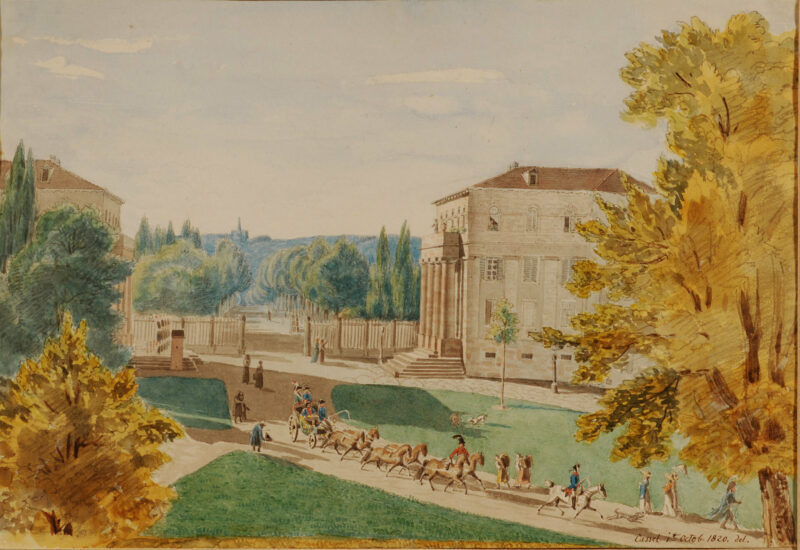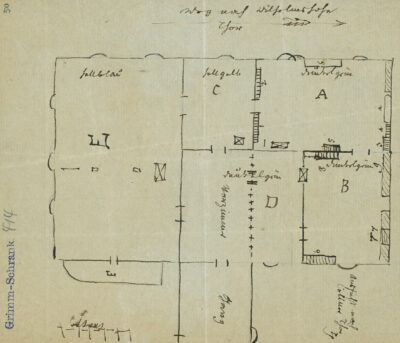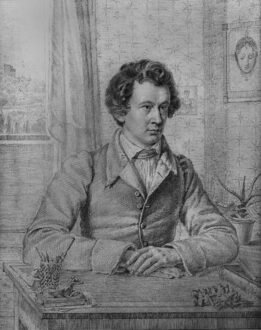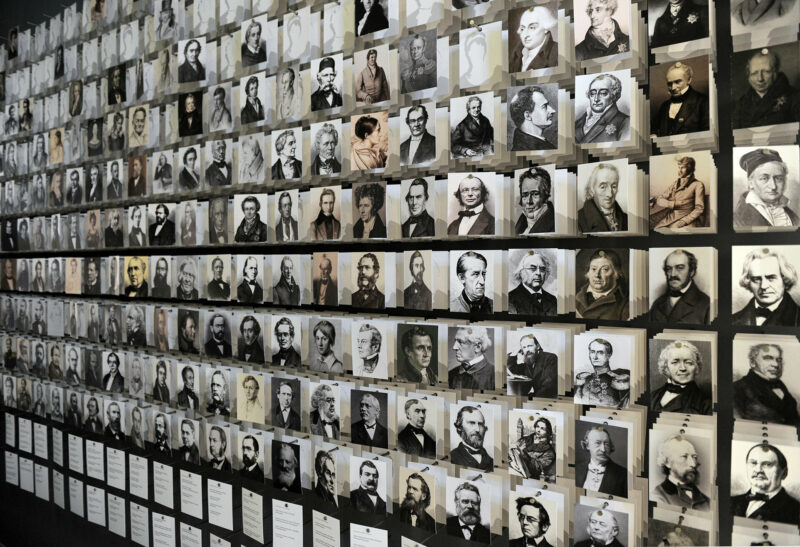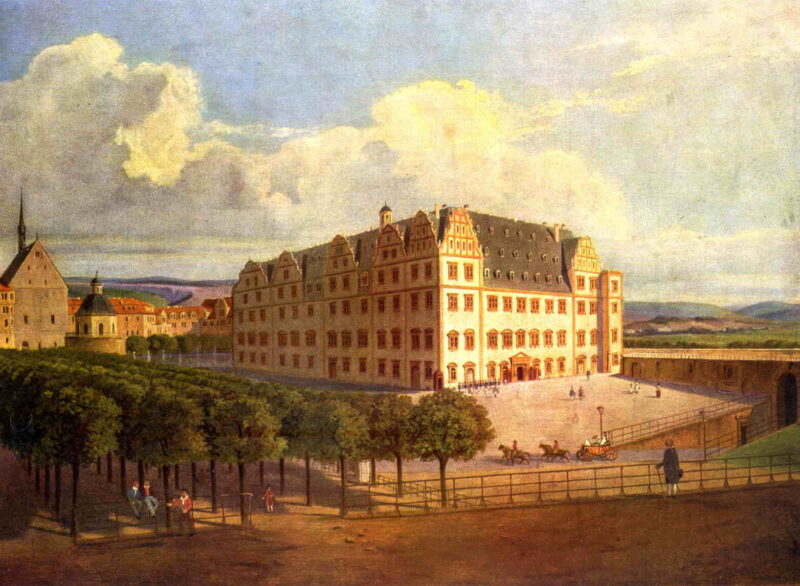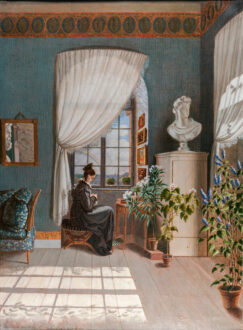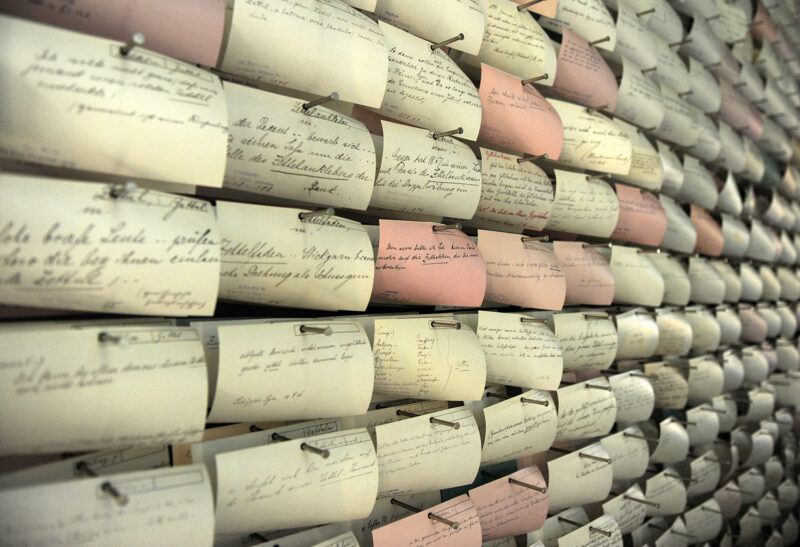- Menu
- Today
-
Next event
Vorlese-Stunde mit den "Omas gegen Rechts"
in der LESEREISpecial Exhibition
I, ANIMAL
Permanent Exhibition
GRIMMWELT adventure space
A biographical journey.
© Kulturstiftung des Hauses Hessen, Museum Schloss Fasanerie, Eichenzell bei Fulda
Kassel as the central hub and focal point in the lives of Jacob and Wilhelm Grimm—a biographical journey.
Standing before the Torwache today one looks out on one of Kassel’s main road arteries. In the din of traffic from Wilhelmshöher Allee, it takes a bit of imagination to picture what it was like when Jacob and Wilhelm Grimm moved here in 1814—quiet and rural, they likely had one of the most beautiful views in town. In a letter to his older brother Jacob, who at the time was working in Paris as a war commissioner for the Elector, Wilhelm Grimm described it thusly: “The building is the last one in town after Wilhelmshöher Allee, the Electress lives there on top, it has columns in front and stands just across from the guardhouse; it is quiet and rural with a magnificent view stretching off into the evening sun.” Across fields and meadows up to Wilhelmshöhe Palace. An excellent place to create one of the most famous fairy tale collections in the world.
Torwache
© Kulturstiftung des Hauses Hessen, Museum Schloss Fasanerie, Eichenzell bei Fulda
Floor plan Torwache
© Staatsbibliothek zu Berlin
Kassel was to be formative for the Brothers Grimm since the career of the linguists began here. The Brothers Grimm described their time in Kassel as the “busiest and perhaps most fruitful time” of their lives. Jacob and Wilhelm Grimm not only compiled the "Children’s and Household Tales" here, they also began work on the "German Grammar" and the "German Dictionary", which became milestones of German linguistics. And just as Kassel had a lasting influence on the lives of the brothers, the legacy of the linguists is still important for the city of Kassel today, where there is an extensive Grimm collection, small parts of which can be seen at GRIMMWELT.
But the lives of the Grimms are not only intertwined with the history of the city. They also reflect Germany’s history as a nation, including Biedermeier society around 1800.
By the time Wilhelm packed everything up for the brothers and moved all their books from the old apartment into their new one in the Torwache, Wilhelm and Jacob Grimm had already been living in Kassel for sixteen years. They were politically exciting years and riveting ones for the brothers. In 1798, after the death of their father, they came to Kassel because their aunt Henriette Zimmer worked here as a maid for the landgravine and could take in her sister’s penniless children. The brothers attended the Lyceum Fridericianum, today’s Friedrichsgymnasium, and lived in a room on “Am Sack” alley, close to the city palace. This is where they lived through historically turbulent times. In 1803, Hesse-Kassel was elevated to an Electorate, whereupon Landgrave Wilhelm IX. appointed himself as Elector Wilhelm I. But just three years later, French troops expelled the Elector and his court from the city palace. In the fall of 1806, Wilhelm Grimm wrote the following in a letter: “The day when all previous conditions collapsed will always remain in my mind: last October evening I observed the French watchfires in the distance with some trepidation, but I couldn’t believe that Hesse was about to come under foreign rule until the morning when I saw the French regiments marching past the old [...] palace in full military splendor. Soon everything changed radically: strangers, strange customs, on the street a strange language spoken aloud among pedestrians.”
These are turbulent times for the Grimms, who are Hessian patriots and distraught over the new situation of foreign rule. Many of their forebears were in the Hessian civil service, their father was a magistrate, and their aunt Henriette was now forced into exile along with the Electress.
Wilhelm Grimm at his desk in the Torwache
© LWL Denkmalpflege, Landschafts- und Baukultur Westfalen
Only one year later, the Grimms had a new neighbor in the city palace: Jérôme Bonaparte moved into the landgrave’s palace on the Fulda with his large court. The residential city of Kassel became the capital of the Kingdom of Westphalia, newly created by Napoleon. Even if Jacob and Wilhelm Grimm were initially skeptical about the new ruler, they certainly benefited from French rule. Jacob applied to be the court librarian, worked in the now renamed Schloss Napoleonshöhe and even rose to become a member of the Westphalian State Council. But civil service bored Jacob, he was interested in returning to his books and studies.
Afterall, the lives of the Brothers Grimm revolve around books. Writing, reading, and collecting had been their great passions since childhood. They analyzed German grammar, compiled words, and later legends and fairy tales, and investigated the origins and evolution of the German language. Jacob and Wilhelm were linguists, folklorists, co-founders of German studies, and were counted among the polymaths of their time. In the course of their lives, they wrote more than 20,000 letters to roughly 1,400 correspondents throughout Europe. This correspondence reached as far as Odessa. At GRIMMWELT, visitors can experience the virtual interactive installation SPIN-NET, and see how the lively correspondence stretched like a network across Europe.
The Brothers Grimm Network
© GRIMMWELT Kassel | Foto: Harry Soremski
The Grimms created a network of scholars and through their letters kept in touch with their publishers, important supporters, literary figures of the time, historians, and politicians. Everything was noted and written down by Jacob and Wilhelm Grimm, mostly on small pieces of paper. This work led to one of their greatest works: the "Deutsches Wörterbuch", the dictionary of the German language.
But until that time comes, Jacob and Wilhelm still had much to experience in the residential city of Kassel. After a lavish party, the city palace was completely destroyed by a devastating fire in November 1811. Napoleon was defeated at the Battle of the Nations near Leipzig, bringing French rule to an end. The French Empire satellite state was dissolved in 1813. Elector Wilhelm I returned to Kassel from his seven-year exile. He first abolished Napoleon’s Code civil and its accompanying liberal legislation. From then on, the Electorate of Hessen, also called Kurhessen, was ruled again in an absolutist manner.
The landgravial residence palace in Kassel
© Wikimedia Commons
Under Wilhelm I, Jacob and Wilhelm worked as librarians for the Museum Fridericianum and had enough free time to pursue their own studies—beginning in 1814 in their new, spacious Torwache apartment, where six family members lived at times, and from 1822 on in a new apartment located on Schöne Aussicht.
View from Wilhelm Grimm's room in the apartment at Bellevue in Kassel (Schöne Aussicht).
© Grimm Sammlung der Stadt Kassel | Illustration: Ludwig Emil Grimm
By 1806, they had started compiling fairy tales and legends. The storyteller Dorothea Viehmann, who came from a Huguenot family and was well versed in the old fairy tales from her homeland, regularly visited the Grimms at the Torwache. According to Wilhelm Grimm, she told her tales “thoughtfully, confidently, with immense vitality and a unique sense of joy, quite uninhibited at first, then, when desired, more slowly a second time, making it possible to copy her words with a little practice.” Friends and acquaintances also contributed stories, including Annette and Jenny von Droste-Hülshoff. The Brothers Grimm put these stories to paper at their desk in the Torwache apartment. Initially conceived as a scholarly collection, Wilhelm made subtle changes to the texts with each new edition, adding idioms and thus ensuring the unmistakable fairytale tone. The first copies of the "Kinder- und Hausmärchen", the "Children’s and Household Tales", later titled Grimms’ Fairy Tales, appeared in 1812. Seventeen editions were released on the market during the Grimms' lifetime.
Lotte in her parlor in the gate guardhouse (Torwache)
© Staatliche Schloesser und Gärten Hessen
The first original, individual copies of the "Children’s and Household Tales" date to 1812 and 1815 and are today the GRIMMWELT’s greatest treasures. Displayed behind armored glass, one can admire the volumes and observe the working methods of the Brothers Grimm. Both volumes have extra wide margins where Jacob and Wilhelm could add notations, including what changes should be made. These editions have been included in Unesco’s world’s documentary heritage since 2005.
The Brothers Grimm’s personal copies with hand-written notes and corrections, known as the "personal copies" of 1812/1815, were added to the UNESCO list “Memory of the World” in 2005.
© GRIMMWELT Kassel | Photo: Sascha Mannel
Elector Wilhelm I died in 1821, and after his death his son, Elector Wilhelm II, also sought to fight the awakening political consciousness of the people. But the changing times can no longer be reversed. Jacob and Wilhelm Grimm now also advocate for more liberal politics. Along with other intellectuals who were critical of Electoral rule, they became members of the so-called Schönfeld circle, which Wilhelm’s first wife, Electress Auguste, gathered around her at Schönfeld Castle.
But the brothers’ political involvements had consequences. The old and embittered Elector denied Jacob Grimm a promotion to the post of Fridericianum director in 1829. So they took a step that “pained their souls,” as historian Johannes Ickler puts it: they accepted an offer from Göttingen to become university professors there. Despite their ties to their hometown, they no longer see any prospects for themselves in Kassel at this time. They leave behind their sister Lotte Hassenpflug as well as their brother Ludwig Emil Grimm, who remain in Kassel until their deaths, where they are buried in the Altstädter Friedhof next to the Lutherkirche.
By 1837, first Jacob and then Wilhelm returned to Kassel. Because the two brothers and five other professors resisted the absolutist aspirations of the new King of Hanover Ernest Augustus, causing a political scandal, they are banned from Göttingen. They may have lost their permanent positions, but are still regarded as some of the most prominent Germanists of their time. And the freedom they gained created space for something new: Leipzig publishers Karl Reimer and Salomon Hirzel made the brothers an offer they could not refuse: creating a dictionary of the German language.
As usual, this work for the brothers started with collecting. In 1838, they began the monumental work they had estimated would take seven years to realize in the contract with the publisher. In the end, it took multiple generations and 123 years until the work was completed with the letter Z in 1961.
There are 1119 slips of paper displayed for the term “Zettel“ alone at the GRIMMWELT today. For their work, the brothers employed a technique that saw greater usage during the eighteenth century: the art of excerpting, copying knowledge from books onto paper notes. These days some might call it “Grimms’ Google.“ These paper notes sometimes only contain short keywords, but often long passages of text. Words were examined for their usage in literature and every find was noted. The words and their meanings were not to be explained in the abstract, but to be derived from their usage in written language. Hence the note-taking never ended. Huge boxes had to be procured for the notes in order to organize and store the knowledge. It is no wonder then that Jacob Grimm felt overwhelmed and wrote that he felt “snowed in by the mass of words coming at me from every nook and cranny.”
The work of the Brothers Grimm was born from bits of paper.
© GRIMMWELT Kassel | Foto: Harry Soremski
Jacob worked on the letters A to C and E to F until his death in 1863, while Wilhelm focused exclusively on the letter D. This work was no longer done in Kassel, however, but in Berlin, where the new Prussian King Friedrich Wilhelm IV brought them immediately after taking office in 1840. This move marked the end of one of the most productive periods in the lives of the Brothers Grimm. The family remained behind as well as a historical treasure for Kassel that has found its home at the GRIMMWELT today.
Author: Amira El Ahl
